Maya deVries is a graduate student studying integrative biology at Berkeley. Mongabay.com’s fourth in a new series of interviews with ‘Young Scientists’.
|
|
If you have never heard of the mantis shrimp, don’t feel bad. Berkeley graduate student Maya deVries, who is becoming an expert on these small crustaceans (related neither to shrimp or preying mantis), admits that until she began her graduate studies mantis shrimp were also unknown to her: “I did not even learn what a mantis shrimp was until I applied to work with my current Ph.D. advisor, Dr. Sheila Patek, at UC Berkeley”.
But Maya’s first look at the mantis shrimp on her advisor’s website left an impression: “I was struck by the amazing capacity of mantis shrimp to capture fish and smash shells with only a few powerful blows, something a fish could only dream of doing. After a more careful read of the website, I realized that the kinds of questions that Sheila aimed to answer in mantis shrimp were very similar to the ones that I was studying… My visit to her lab marked my first exciting encounter with mantis shrimp. Hearing the animals smash their snail prey for the first time convinced me that these were the animals that I wanted to study.”
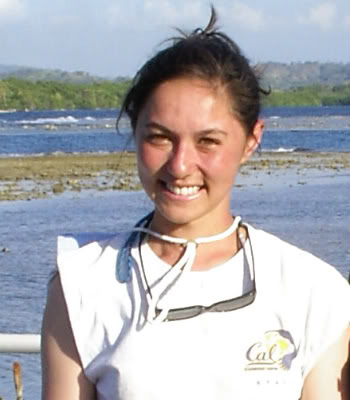 Maya deVries at the Galeta Marine Laboratoty in Panama. |
According to deVries, mantis shrimp are super crustaceans: “they are ‘number one’ in so many ways. First, the mantis shrimp’s predatory strike has been documented to produce one of the fastest appendage movements ever reported in the animal kingdom. […] Second, mantis shrimp are one of the fastest speeds swimmers in the sea. […] Third, mantis shrimp have one of the most complex visual systems in the animal kingdom. […] Unlike humans who only have three visual pigments, mantis shrimp have 16. […] Finally, mantis shrimp are considered to have one of the most complex communication systems in crustaceans, because of the many ways in which mantis shrimp signal to each other. For example, the males of some species have polarized signals on their tails and by their antennae which they use to signal to females.”
Maya de Vries and her advisor, Dr. Sheila Patek, have spent a lot of time looking at the mantis shrimps’ super-fast, super-powerful appendages. There is simply nothing else like it.
“The claw acts like a bow and arrow in both spearing and smashing mantis shrimp. When you shoot an arrow, the first thing you do is slowly pull back on the bow so that the energy from your arm muscles loads the bow. When you release the bow, all of the energy built up in the bow is released over very short time scales, causing the arrow to fly forward at speeds much faster than would have been possible if you had just thrown the arrow with your arm alone. The mantis shrimp claw follows the same concept,” deVries says, explaining how these small creatures’ claws are able to reach record speeds.
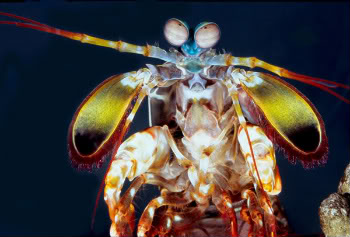 The strange-looking and beautiful mantis shrimp. This species is Odontodactylus scyllarus. Photo by Roy Caldwell. |
These strikes are so fast and potent that they actually create ‘cavitation bubbles’. “Cavitation bubbles are vapor bubbles that form when water moves really fast. Basically, when water moves fast enough, areas of low pressure are created, which causes the water to vaporize and form cavitation bubbles. […] When these bubbles burst, energy is released in the form of light, heat, and sound,” deVries explains.
Maya deVries and Dr. Patek have recorded these strikes in high-speed videos (two videos are available at the end of the article) and one can see on film a flash of light as the mantis shrimp’s strikes. This is the cativation bubble.
Maya says that while hardly any of the species of mantis shrimp are classified as endangered, they are threatened by the aquarium trade and overfishing. “The aquarium trade has probably devastated populations of mantis shrimp the most,” says deVries. “Some of the most colorful and charismatic species are found in coral and coral rubble in the Indo-West Pacific. Aquarium traders collect these species with underwater cyanide bombs that stun all reef animals and decimate entire coral reef habitat. This practice not only seriously damages mantis shrimp populations, but it also demolishes entire coral reef ecosystems.”
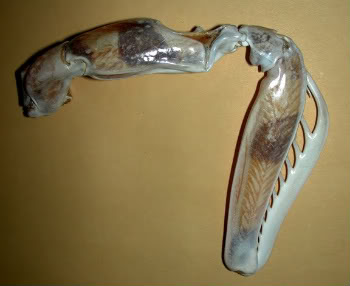 Predatory appendage of mantis shrimp Lysiosquillina maculata. Photo by Roy Caldwell. |
In her quest to make these remarkable animals more widely known, Maya deVries has started a Facebook page celebrating the mantis shrimp, also known as stomatopod: Oscar Stomatopod
Maya deVries discussed the evolution, feeding habits, and lightning-fast appendages of various species of mantis shrimp, as well as studying integrative biology at Berkeley and working at the world renowned Smithsonian Tropical Research Institute in Panama in a August, 2009 interview with Mongabay.com.
BACKGROUND
Mongabay: How did you become interested in wildlife? What is your background?
Maya deVries: I grew up about an hour away from the Pacific Ocean in Berkeley, CA and so the ocean was always a big part of my life. Growing up, I sent a lot of time exploring the tide pools and sandy beaches that are typical in northern California. However, my true fascination with the ocean is the warm tropical waters of coral reef ecosystems. My first introduction to the incredible diversity of life in coral reefs occurred no more than ten feet away from the shoreline. I took only a few steps into the aqua waters of Tahiti, French Polynesia before noticing humbug damselfish darting in and out of patches of coral, graceful stingrays gliding past my feet, and iridescent pipefish hovering near the surface of the water. My curiosity in coral reef animals began at this pivotal moment during college and I have been pursuing this interest ever since.
Mongabay: How does the integrative biology program at Berkeley differ from other biology graduate programs?
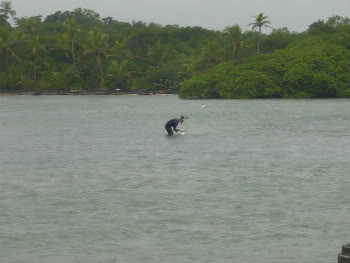 Maya deVries collecting coral rubble at Galeta Marine Laboratory in Panama. |
Maya deVries: Integrative Biology is different from other biology graduate programs, because it is a mix of a whole bunch of different biology disciplines. Unlike other programs, we have everything from ecology research on plants to evolutionary development research on crustaceans, all in the same department. The goal of the department is literately to integrate many levels of study in biology so that we can gain a more comprehensive understanding of life on earth.
Mongabay: You are currently at the Smithsonian Tropical Research Institute, what is it like working at this world-renowned facility?
Maya deVries: My field work on mantis shrimp feeding ecology occurs at the Smithsonian Tropical Research Institute (STRI), which is truly an exciting place to work. Scientists come from all over the world to conduct research at STRI. In fact, STRI itself has 38 staff scientists who study the many aspects of Panama’s tropical flora and fauna, both in the water and on land. My particular field site is on the Caribbean coast of Panama at the Galeta Marine Laboratory. Galeta Marine Laboratory is one of the six field stations that are run by STRI. This is a beautiful site with a dynamic inner-reef flat, white sand beaches, and mangroves. One of my favorite things about working at this site is actually its active marine education program. This program brings school groups from all over Panama to the marine station so that students can learn about the natural history of the area. This program has become a great outlet for teaching about marine biology, ecology, and conservation.
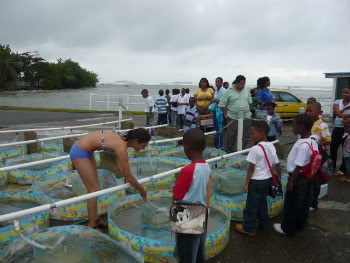 Maya deVries explaining to local elementary children about her feeding experiment at Galeta. |
Mongabay: Can you tell us what led you to work with the strange and little-known mantis shrimp?
Maya deVries: Surprisingly, I did not even learn what a mantis shrimp was until I applied to work with my current Ph.D. advisor, Dr. Sheila Patek, at UC Berkeley, who is now moving to the University of Massachusetts Amherst. As an undergraduate, I conducted research in a lab that focused on understanding the evolution fish feeding. I came across the Patek Lab website when I was considering graduate school and looking for potential Ph.D. advisors. I was struck by the amazing capacity of mantis shrimp to capture fish and smash shells with only a few powerful blows, something a fish could only dream of doing. After a more careful read of the website, I realized that the kinds of questions that Sheila aimed to answer in mantis shrimp were very similar to the ones that I was studying in fish feeding systems. I wrote an email to Sheila describing why I thought our interests were well-matched and we set a time to meet in person. My visit to her lab marked my first exciting encounter with mantis shrimp. Hearing the animals smash their snail prey for the first time convinced me that these were the animals that I wanted to study.
Mongabay: Why do you think so little is known about mantis shrimp?
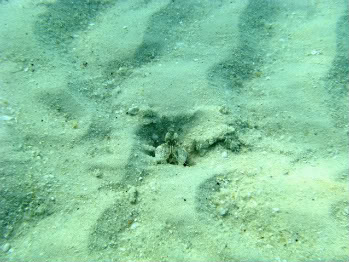 Lysiosquillina maculata peaking its head out of its sandy burrow at Lizard Island, Australia. Photo by Erica Staaterman. |
Maya deVries: Mantis shrimp are very elusive animals in the wild. Unlike the fish, mantis shrimp are not the first thing you notice when you go snorkeling on a coral reef. Mantis shrimp hide from predators in crevices and cavities that they find in coral and dead coral rubble. Some species also dig burrows in sand and mud flats. Yet, even these burrows are hard to find, because mantis shrimp cover the entrances of their burrows with mucous and sand to protect themselves from predators. This means you can only see mantis shrimp when they peak their eyes out of their sand burrows and coral cavities looking for prey, or when they are darting from cavity to cavity in search of prey.
Mongabay: What advice would you have for an undergraduate who is interested in applying to graduate school in biology?
Maya deVries: If you are interested in graduate school, I think the most important thing you can do is to get involved in research. There are usually many opportunities for research at universities for college students and even high school students. Don’t feel shy about surfing the web for labs that suit your interests and then emailing the professor who runs the lab to see if you can volunteer in the lab. Most professors are excited to learn that people are interested in their research, so it’s definitely worth a try. Also, research is not right for everyone and so you really want to know if you would be happy conducting research before committing to it in graduate school. One program that I would recommend is the National Science Foundation’s Research Experience for Undergraduates Program (
Filmed at 5,000 frames per second, a peacock mantis shrimp strikes the shell of a snail. The flash that occurs a moment after impact is the cavitation.
Video of a spearing mantis shrimp in action.
Related articles
Plant communities changing across the globe, says scientist Sasha Wright
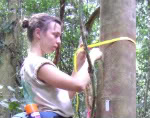
(03/29/2009) Having studied plant communities across three continent and within widely varied ecosystems—lowland tropics, deciduous forests, grasslands, and enclosed ecosystems on hill-tops—graduate student Sasha Wright has gained a unique understanding of shifts in plant communities worldwide as they respond to pressures from land use and global climate change. “Plant communities are certainly changing,” Wright told Mongabay.com in a March 2009 interview. “These changes are undoubtedly affected by an increased occurrence of extreme weather events, temperature fluctuations, atmospheric CO2 concentrations, human land use, and in some cases urbanization of populations.”
Seeking out the world’s rarest and most endangered birds

(02/02/2009) For an evolutionary biologist there is no conservation group whose work is more exciting than EDGE, a program developed by the Zoological Society of London (ZSL). Unique in the conservation world, EDGE chooses the species to focus on based on a combination of their threat of extinction and evolutionary distinctness. Katrina Fellerman, an evolutionary biologist herself and the EDGE birds’ coordinator, describes the organization as one that focuses on species, which “to put it bluntly, if lost, there would be nothing like them left in the world today”. Explaining further Fellerman says “We use evolutionary distinctiveness (ED) as a species-specific measure of the relative evolutionary value of species – it is a way of apportioning conservation value according to a species’ phylogenetic position. Species with few or no close relatives on the ‘tree of life’ have the highest ED scores.”
Embarking on a career in science? Learn from interviews with young scientists
(02/02/2009) Mongabay.com is excited to announce a new series of interviews with ‘young scientists’. These interviews will focus on scientists who while only recently starting their career have already achieved notable success.

(01/27/2009) After a year studying marine biology at Moss Landing Marine Labs, Liz McHuron headed off to the little-known nation of Suriname to monitor leatherback sea turtles. Her responsibilities included implementing a conservation strategy for a particular beach, moving leatherback nests in danger of flooding, and educating volunteer workers on the biology, behavior, and conservation efforts of the world’s largest, and most unique, marine turtle. I visited McHuron during her time at the beach of Galibi in Suriname; she proved to be the sort of scientist who refused to be deterred: breathtaking humidity or downpours, fer-de-lances on the beach or jaguars, Liz was always on the move, always working to aid the critically-endangered leatherbacks while studying them with the thoroughness inherit in a born scientist.